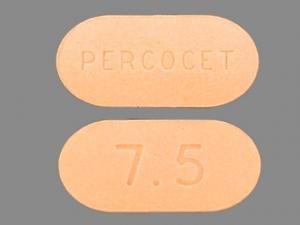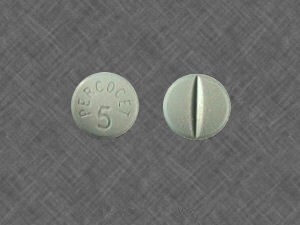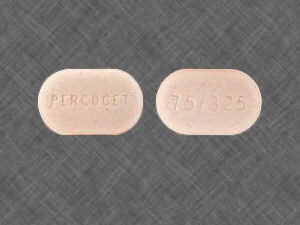Showing all 5 results
-

Percocet 7.5/500mg
$349.00 Read more -

Percocet 2.5/325mg
$319.00 Read more -

Percocet 5/325mg
$329.00 Read more -

Percocet 7.5/325mg
$339.00 Read more -

Percocet 10/325mg
$369.00 Read more
What is the use of Percocet
Percocet is a prescription medication and a brand name for generic drug Acetaminophen/Oxycodone. Oxycodone and Acetaminophen are the main active ingredients of this medication. Oxycodone is an opioid pain medication, and acetaminophen is a less potent pain reliever substance.
Oxycodone is a white crystalline powder derived from the opium alkaloid, thebaine. It may dissolve in water and slightly soluble in alcohol. Acetaminophen is a non-opiate, non-salicylate analgesic. Available as a white, odorless crystalline powder.
- Colloidal silicon dioxide
- Microcrystalline cellulose and croscarmellose sodium
- Stearic acid and pregelatinized cornstarch, etc.
This medication is used to relieve moderate to severe pain. Patients may buy Percocet online for medical purposes. This drug may also be used for purposes not listed in this medication guide.
In the United States, Percocet is a schedule II-controlled drug substance under the controlled substance act (CSA).
How supplied
This medication is available for medical use in 4 different strengths and different colors and shapes.
- 2.5 mg/325 mg: Pink, oval, tablet form, debossed with “Percocet” on one side and “2.5” on another side.
- 5 mg/325 mg: Blue, round, tablet form, debossed with “Percocet” on one side and “5” on another side.
- 7.5 mg/325 mg: Peach, oval, tablet form, debossed with “Percocet” on one side and “27.5/325” on another side.
- 10 mg/325 mg: Yellow, capsule-shaped, tablet form, debossed with “Percocet” on one side and “10/325” on other side.
Dosage
Medical professionals should prescribe your dosage on the base of your physical, mental, and medical conditions.
Initial dosage for adults
You may initiate your treatment with PERCOCET 2.5 mg/325 mg tablets. Take 1 or 2 tablets every 6 hours as needed for pain. The total daily dose of acetaminophen should not exceed 4 grams.
Usual adult dosage
Take 1 tablet every 6 hours, and the total daily dose of acetaminophen should not exceed 4 grams.
Precautions
Patients should take some necessary precautions while using this medication to get the maximum benefit of drug and protection from adverse effects.
How to use OxyContin?
· Patients should use Percocet precisely as prescribed by their doctor. We will suggest you read the prescription label before initiating the treatment.
· You may take this medication by mouth with or without food as per your doctor’s recommendation.
· This medication can be habit-forming while using it through unnecessary dosage.
· We suggest you order Percocet online to avoid duplicate products.
· Do not stop taking Percocet; suddenly, it can cause severe withdrawal symptoms.
You should take medical consultation before using Percocet if you have or ever had any of below-given conditions;
- A history of drug or alcohol addiction
- Liver or kidney diseases
- Seizures or a head injury
- Urination problem
- Problem with your thyroid or gallbladder
Don’t use Percocet if you have/are;
- Allergic to Percocet or any component of this medication
- Severe breathing problems or asthma
- A blockage in your stomach or intestine
- Nursing or pregnant lady
Side effects
Percocet can cause some severe unwanted effects in some adverse conditions. You should contact your doctor to take medical attention if you have any of the below-given effects during the treatment.
(Note- This document contains side effects information about Oxycodone and acetaminophen, some of these effects will not apply to the brand name Percocet)
Less common
- Black, tarry stools
- Chills
- Dizziness
- Dark urine
- Fever
- Headache
- Light-colored stools
- Nausea
- Loss of appetite
- Bloody vomiting
- Stomach pain
- Itching or skin rash
- Unpleasant breath odor
- Unusual tiredness or weakness
- Yellow eyes or skin
Rare
- Cough
- Fever with or without chills
- A general sense of tiredness or weakness
- Hoarseness
- Lower back or side pain
- Painful or difficult urination
- White spots (including sores and ulcers) on the lips or in the mouth
- Unusual bleeding or bruising
Unknown incidence
- coughing that sometimes produces a frothy pink sputum
- decreased awareness or responsiveness
- decreased frequency or amount of urine
- Difficult or labored breathing
- Difficult, fast, noisy breathing
- Difficulty in passing urine (dribbling)
- Difficulty with swallowing
- Drowsiness
- Dry mouth
- Extremely shallow or slow breathing
- Fainting
- Fast or deep breath
- Pounding in the ears
- Puffiness of the eyelids or around the eyes, face, lips, or tongue
- Rapid, deep or shallow breathing
- Redness of the face, neck, arms, and occasionally, upper chest
- Restlessness
It is not a complete list of side effects of Generic Percocet. You should take a medical consultation if you have any abnormal results while using Percocet.
